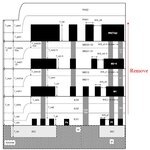junsik
Junior Member level 2

Hi I want to remove the passivation, IMD, metals on the die to take SEM image of the gate.
Please see the figure i uploaded.
How can i remove the passivation, IMDs, and metal lines without the damage on the poly gate of the mosfet??
it is so difficult to find the proper way
Please help me!
thank you

Please see the figure i uploaded.
How can i remove the passivation, IMDs, and metal lines without the damage on the poly gate of the mosfet??
it is so difficult to find the proper way
Please help me!
thank you



